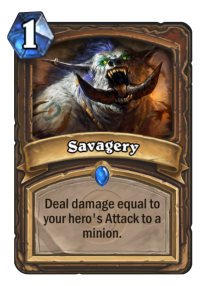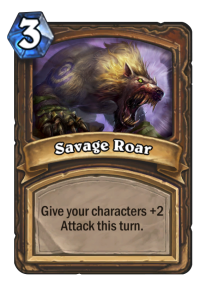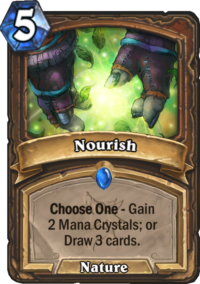Though the recent developer AMA has confirmed that Team 5 are not planning to make sweeping balance changes anytime soon, the community furor around Druid’s current build pretty much forced their hand when it came to Kael'thas Sunstrider and made us wonder about the past of the class and the kind of decks and archetypes which were eventually whacked by the nerf bat. How did Druid change across the years and what’s it like when it reaches critical mass? It’s time to take a trip down memory lane to find out.
The Primordial Days

Though the early years of Hearthstone saw remarkably few changes made to cards and decks alike – something that was especially true in the case of Druid – a quick look at the patch notes from the alpha and beta days serves as an interesting reminder of how different the game used to be. Druid of the Claw used to have seven health, Naturalize (now a Hall of Fame member) was buffed from two mana to one, Force of Nature used to cost just five (and not six) even back when it summoned charging Treants…
Notably, Druid’s burn and AoE resources were basically swapped. Savagery used to deal its damage to all enemy minions, originally for two, then three mana, making Bite and Claw (also adjusted) strong contenders at the time. Meanwhile, Wrath and Starfall could target enemy heroes as well, guaranteeing some pretty nutty burn options.
The reason I devoted two paragraphs to discussing pre-release changes to Druid is because of the incredible gap that comes next: believe it or not, none of its class cards were nerfed until the introduction of the Standard format in 2016. This is quite incredible even if you consider how much longer it took the community to consume the content in the game – with no easily accessible stats sites and a much lower overall proficiency in the game, it took much longer to figure out metagames and it made sense to wait for the launch of the next set if a problematic card or archetype emerged late into an expansion. By the same token, Team 5’s solution to Druid’s strong Classic set was to continuously print janky junk after janky junk for it in every set, which hasn’t stopped the class to remain competitive at the highest levels based off of its infamous Force of Nature + Savage Roar setup.
You may find it hard to believe, but there were times when it wasn’t commonly understood that you should run two copies of a two-card combo which can deal 14 damage from hand. The midrange-y Druid deck with this sort of a finisher remained the backbone of the class for years, apart from the occasional experimentation with ramp-heavy decks which were just a pale imitation of the kind of stat-vomiting capability we’ve seen in the last few years. In fact, if you look at the neutral nerfs, it was basically just the Big Game Hunter change that impacted Druid, depriving it from an efficient hard removal tool which was basically omnipresent at the time in non-aggro decks at 3 mana. Meanwhile, cards like Emperor Thaurissan or Shade of Naxxramas greatly improved its general gameplan.
Standardized Testing

Enter Whispers of the Old Gods and the Standard game mode in April 2016, and with it, three massively impactful nerfs to Druid. Though Force of Nature’s complete rework (from “Summon three 2/2 Treants with Charge that die at the end of the turn” for six mana to what it is today) is the most memorable one, the gutting of Keeper of the Grove (previously a 2/4) and Ancient of Lore (reducing its card draw option from two to one) also greatly hurt the class. Based on a community survey at the time, the nerfs to these auto-include cards were generally welcomed by the playerbase. Druid nevertheless remained competitive even in those days thanks to a Fandral Staghelm-fueled token deck, topped off by one of the most controversial cards in the game’s history: Yogg-Saron, Hope's End.
Once again, it was the neutral card which got the hit as Team 5 made Yogg stop casting spells when it leaves the board in October of the same year, a change they’ve eventually reverted for Wild. (Something similar would happen with Spiteful Summoner later down the line.) The problem with Yogg-Saron was that it essentially served as an emergency lever for aggressive decks like Token Druid and Tempo Mage, with a downside that simply didn’t come into play as you just kept the card in your hand if you were already winning. Hey, if the random spells screw you over in a game state where you were already losing, where’s the harm, right? This dynamic, coupled with the fact that you juiced up the Battlecry effect by playing in a normal way using the spells you’d use anyway, made this Old God infuriating to go against.
With the rise of Highlander decks and Patches the Pirate-fueled shenanigans in Warrior and Shaman, Druids took a step back in the MSoG meta but came back strong in Journey to Un’goro with an aggressive token build leveraging Patches-based early board presence with the curve-toppers of Living Mana and Bittertide Hydra. From this point onwards, Druid class card nerfs would become more common, almost exclusively focusing on a key aspect of its identity – the ability to ramp up in mana – leaving brutal payoff cards like Ultimate Infestation untouched.
Growth Potential

A patch in September 2017 was mostly focused on the Classic set, with the notable exception of Spreading Plague, which turned out to be way too good of a stall tool at five mana (and still a premium option at six). However, a nerf to Innervate has turned it into another Coin instead of an Overload-free Lightning Bloom, which meant that it was no longer able to enable tempo-cheating strategies and was often cut from decks which didn’t rely on 11-mana turns. A year later, Aviana was bumped up to ten mana to combat a popular combo setup in Wild with Kun the Forgotten King (not to mention its heavy synergy with Juicy Psychmelon). Just two months later, Wild Growth and Nourish were made more expensive in a bid to make them less of an auto-include, essentially gutting any ramp-based archetype until better versions of the same card were printed in 2019 and 2020.
No wonder Druid was left alone for a long while after this mutilation: the only other class card nerf came in July 2020 to Fungal Fortunes, despite the much more frequent balancing changes. Even though technically the first Kael'thas Sunstrider nerf from July may seem like a Druid thing, it could have also been made to target the popular Demon Hunter OTK builds at the time. Right now, the latest mana-cheating Druid deck is perhaps the most degenerate of them all, but even the upcoming change to the card has kept its fantasy alive. We may get to play around with – and against – cheapo Survival of the Fittest stuff for at least a little while longer.
Conclusion
So where does this leave Druid? The paradox of the class is that its versatile enough to reinvent itself time after time, still making good use of its diminished evergreen set, yet seemingly locked into the same sort of archetypes throughout the game’s history: early mana cheating followed by (quasi-)OTK finishers or token-based strategies aimed to go for the kill with Savage Roar. Chopping and changing their class cards – and then replacing them with eerily similar alternatives – did little to help with this matter, and if conditional replacements of previous evergreen tools are the future of Druid, all of this is unlikely to change.

At this point i would like to see class-reworks on the classic set. Every class has a number of cards that are just more powerful than the rest, and every class has a couple of cards that are just unplayable (i.e. blade flurry). Aside from that i think they should really define the class identities right from the classic set, letting more room for improvisation on the upcoming expansions.
Druid is a paradox. It’s class identity is supposed to be
1) the force (big beasts)
2) of nature (plant tokens)
3) will rise against you (ramp).
Every time blizzard makes enough cards for druid to what he does best, players complain that “it’s cheat”. Cheating out two 5-drops on T3 or a swarm on T2 is literally what druid is supposed to be able to do thematically. I’m not saying that it isn’t annoying to face. If you don’t like it, tech against it. I don’t see the complaints to be well founded.
I happen to not play druid, partially because I don’t play “tier 1 meta decks” unless I built it myself. Just my personal playstyle.
I wish Keeper and Nourish got un-nerfed, I could really use that for my quest druid. I don’t like the Guardian Animals BS…
(Copying my reply to another comment since it’s basically the same topic)
There was a similar question in the last AMA and they said that they’re working on a major overwork of the Basic/Classic set (currently planned to release with the next rotation). I would imagine some of the cards will get unnerfed / we might get new versions of them altogether.
But yes, cards like Keeper of the Grove or Ancient of Lore should get unnerfed IMO. Nourish for example – hard to say, it’s already good at 6 in Quest Druid for example, I think that it can stay that way.
I don’t understand why did not reverse some nerfs like Keeper of the groove and Ancient Lore.
In particulary the last one it would not be played even with draw 2 however there is a cat that draw 2 (even more sometimes) that cost 2 less mana…
There was a similar question in the last AMA and they said that they’re working on a major overwork of the Basic/Classic set (currently planned to release with the next rotation). I would imagine some of the cards will get unnerfed / we might get new versions of them altogether.
But yes, cards like Keeper of the Grove or Ancient of Lore should get unnerfed IMO. Nourish for example – hard to say, it’s already good at 6 in Quest Druid for example, I think that it can stay that way.